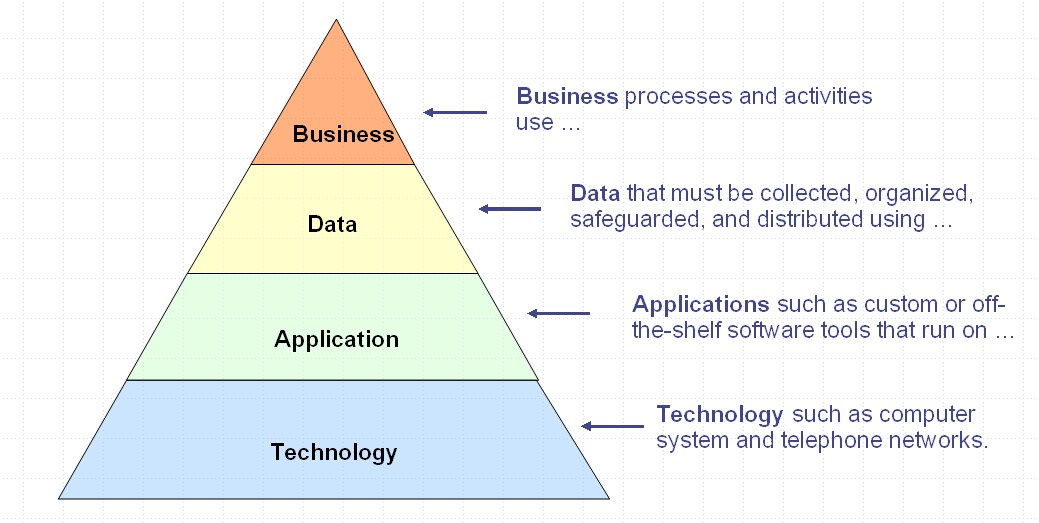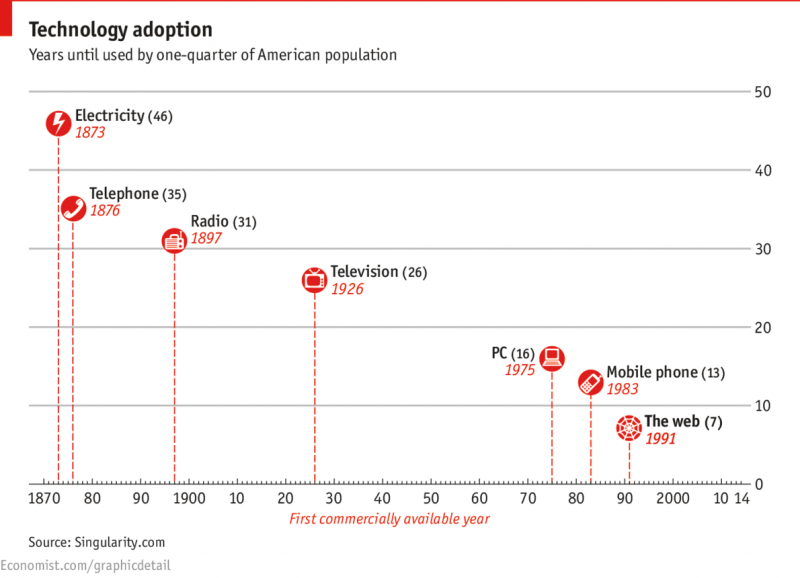Posts Tagged EA874 Topic 1
How do you Adopt?
Digital Disruption, Part 3
Originally in 1962, and most recently in 2003, professor Everett Rogers detailed a systematic system by which innovation is adopted. In his book, Diffusion of Innovations, Rogers states that adopters of innovation (or in our current discussion, technology) can be broken down into 5 distinct groups of Innovators, Early Adopters, Early Majority, Late Majority and Laggards.
Image Source: phdsoft
Rogers breaks down the 5 categories as such (Rogers, 2003):
- Innovators – 2.5% of the population. Innovators are willing to take risks, youngest in age, have the highest social class, have great financial lucidity, very social and have closest contact to scientific sources and interaction with other innovators. Their high risk tolerance gives them the flexibility to try new technologies that are not yet proven out.
- Early Adopters – 13.5% of the population. These individuals have the highest level of opinion leadership (the process by which a person influences the attitudes or actions of another person informally) among all the adopter categories. Early adopters are typically younger in age, have a higher social status, have more financial lucidity, advanced education, and are more socially forward than late adopters. They tend to be more discreet in adoption choices than the early adopters which enables them to have a greater voice in opinions.
- Early Majority – 34% of the population. They adopt innovation after a varying degree of time, which is significantly longer than innovators and early adopters. Early Majority have above average social status, contact with early adopters and seldom hold positions of opinion leadership in a system.
- Late Majority – 34% of the population. These individuals will adopt innovation after the average adopter. They approach an innovation with a high degree of skepticism. Late majority adopters have below average social status, little financial liquidity, and very little opinion leadership.
- Laggards – 16% of the population. They are the last to adopt an innovation. These individuals typically have no opinion leadership at all, they have an aversion to change-agents, and tend to be advanced in age. Laggards typically tend to be focused on “traditions”, likely to have lowest social status, lowest financial fluidity, be oldest of all other adopters, and socially in contact with only family and close friends.
This breakdown by Rogers was based on many years of research and market study. We can see that age, social status, finances and personal influence have a large impact on the categories of adopters. This makes sense as younger people are typically overall more willing to take risks compared to older generations. The amount of finances available to you also directly impacts the level of risks you are willing to take. And the social aspect is a fascinating addition to the equation. The more socially connected you are, the higher the chance of you finding out about a new innovation. Word of mouth at first, and then marketing later can help spread information regarding new innovations, allowing more and more individuals to investigate the innovation and decide on their participation.
This same model converts directly into the business environment. Business Analyst Daniel Newman described in Forbes magazine how those same 5 categories apply to people within your organizations (Newman, 2016):
- Innovators – Innovators are the visionaries willing to try new ideas and take risks along the way.
- Early adopters – People in this category are the thought leaders and change drivers within an organization. They may not express a willingness to try anything that comes along, but they’re comfortable with change and helping others understand the importance of change. Some organizations refer to these individuals as technology champions.
- Early majority – These individuals aren’t thought leaders, but they are the people you see lined up outside of a store on the day a new technology comes to market. As soon as they see the demonstrated benefits of a change, they’re willing to jump on board.
- Late majority – Typically skeptics, this population waits until a larger population adopts an innovation to invest time and effort making a change.
- Laggards – Every organization has individuals “stuck in their ways.” Convincing these individuals to make a change is challenging.
Newman goes on to say that in order for organizations to be able to adopt new technologies, individuals within the organization need to demonstrate the Innovator, Early Adopter and Early Majority traits in order to successfully integrate the technology at a reasonable pace.
Are you an Innovator? An Early Adopter? Or are you a Laggard? A simple look at the technology you use day-to-day may tell others more than you realize.
References:
Newman, Daniel. (2016). Why you should align your Business Transformation too the Adoption Bell Curve. Forbes. Retrieved August, 30, 2017 from https://www.forbes.com/sites/danielnewman/2016/05/31/why-you-should-align-your-business-transformation-to-the-adoption-bell-curve/#264c11721160
Rogers, Everett. (2003). Diffusion of Innovations. Free Press.
Disruptors set to Maximum….
Digital Disruption, Part 2
(for the non Star Trek fans in the room, Klingons typically use a weapon called a disruptor)
So what do we mean when we say that technology is disruptive? A simple definition, as provided by Technopedia, is “Disruptive Technology refers to any enhanced or completely new technology that replaces and disrupts an existing technology, rendering it obsolete.” Disruptive technology can be hardware, software, networks, new processes and any combination of those as well. Typically, the success of a disruptive technology is unexpected. This is due to the fact that most disruptive technologies lack refinement, have some performance problems, are only known to a limited audience and may not yet have practical applications at the time of their creation (Christensen, 1997). It’s not until later, once some of those issues are addressed, that the existing technology starts to be impacted and potentially threatened.
Another aspect of disruptive technology is that once it starts being adopted, it has the potential to transform the way we live and work, enable new business models, and provide a way for new companies to upset or disrupt the established order (Manyika, et.al. 2013). At first glance, that may seem exaggerated, yet consider this list of technologies that were/are considered as disruptive at their time in history:
- Steam Power
- Assembly Line Manufacturing
- World Wide Web / Internet
- Personal Computer
- Mobile Phones / Smartphones
- Video Streaming
- Cloud Technology
There are hundreds more examples of technology that we take for granted today, which when it became public, it may not have been well accepted. I doubt any of the original creators of these ideas had a concept of how great an impact their creation would have on the future society. And the technologies that were replaced were firmly entrenched as the “leaders” of their realm. Yet, can we image a world today without any of these technologies? And if these technologies alone had such a huge impact on our society, then what is in store in the future? There are emerging technologies that we see today such as 3D printing, self-driving vehicles, robotics & AI, the Internet of Things, and virtual reality. We can already begin to see the impact these technologies have on consumers and companies are starting to be impacted as well.
What’s the next big thing around the corner and how much will it change our society? And how do we adopt these new technologies?
References:
Christensen, C. (1997). The Innovator’s Dilemma: Management of Innovation and Change. Harvard Business School Press.
Manyika, J., Chui, M., Bughin, J., Dobbs, R., Bisson, P., & Mars, A. (2013). Disruptive Technologies: Advances that will transform life, business and the global economy. McKinsey Global Institute. Retrieved August 29, 2017 from http://www.mckinsey.com/business-functions/digital-mckinsey/our-insights/disruptive-technologies
Back in the Saddle again…
Digital Disruption, Part 1
This semester (Fall 2017), once again, I will be blogging regarding my reading topics throughout the course. The class focus this time is specifically Enterprise Architecture: Information Technology Architecture.
As I detailed roughly a year ago, Enterprise Architecture (EA) itself can simplistically be considered the intersection of Business, Strategy and Technology. But if we look deeper into the overall concept of EA, we find that it can be easily broken down into smaller domains or layers. As detailed in this diagram created by Niles Hewlett from the USDA Enterprise Architect team back in 2006 (courtesy of Wikipedia), the 4 layers of EA are distinct, yet exist dependent on each other.

Throughout this course, we will dive deeper into each of the layers, exploring how they interact with each other and, more importantly, how different technologies and trends impact the overall architecture and each layer individually as well.
The Fast Pace of Technology Adoption
As we all know and experience frequently, technology is changing at an ever-increasing pace. Today’s hot trends can quickly become tomorrows old news. In considering this challenge, we need to be cognizant that this is two separate issues that compound each other. First, advances in technology itself are accelerating. As expounded in his book, The Singularity is Near, author Ray Kurzweil states, “Evolution (of technology) results in a better next-generation product. That product is thereby a more effective and capable method, and is used in developing the next stage of evolutionary progress. It’s a positive feedback loop” (Kurzweil, 2006). In other words, we are using better & faster tools to design and create better & faster tools. As the end product is improved, this then cuts down on the next stage of development, which in turn shortens the next development phase.
Secondly, adoption of said technology advances are accelerating as well. From end-user consumption of modern technology to the use of technology in business, the differences that we see compared to even 10 years ago is astounding and shocking. As noted by Rita Gunther McGrath, “It took decades for the telephone to reach 50% of households, beginning before 1900. it took five years or less for cellphones to accomplish the same penetration in 1990” (McGrath, 2013). The below chart was assembled by the Economist from data provided in Kurweil’s book. It shows not only the fast adoption of cellphones and the Internet, but other “new” technologies that have had a large impact on society over the past 150 years or so.
As society rapidly adopts technology, this quickly filters into the business world as well. An organization faces an even bigger challenge to be able to integrate the new technology into it’s business practices and strategy without bringing about major disruptions to the operation of the organization. More about that next….
References:
Kurzweil, Ray. (2006). The Singularity is Near: When Humans Transcend Biology. New York. Penguin Books.
McGrath, Rita Gunther. (2013). The Pace of Technology Adoption is Speeding Up. Harvard Business Review. Retrieved August 28, 2017 from https://hbr.org/2013/11/the-pace-of-technology-adoption-is-speeding-up



